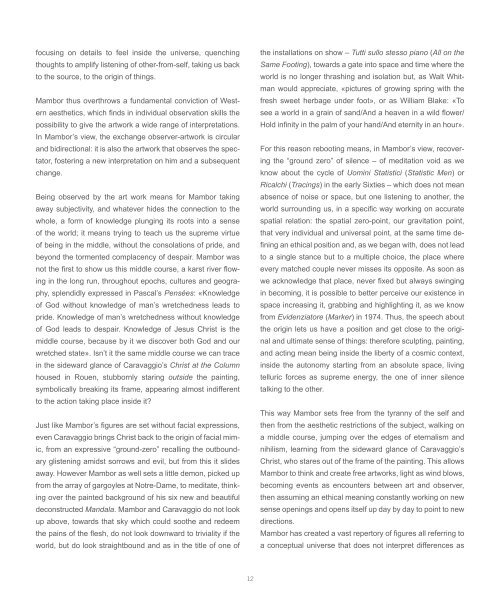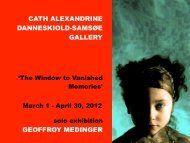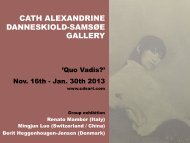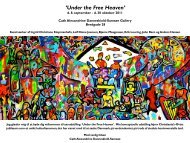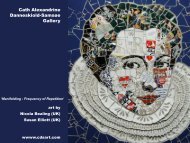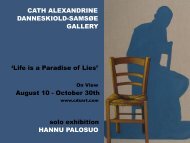Renato Mambor
RENATO MAMBOR - cds art & visibility
RENATO MAMBOR - cds art & visibility
Create successful ePaper yourself
Turn your PDF publications into a flip-book with our unique Google optimized e-Paper software.
focusing on details to feel inside the universe, quenchingthoughts to amplify listening of other-from-self, taking us backto the source, to the origin of things.<strong>Mambor</strong> thus overthrows a fundamental conviction of Westernaesthetics, which finds in individual observation skills thepossibility to give the artwork a wide range of interpretations.In <strong>Mambor</strong>’s view, the exchange observer-artwork is circularand bidirectional: it is also the artwork that observes the spectator,fostering a new interpretation on him and a subsequentchange.Being observed by the art work means for <strong>Mambor</strong> takingaway subjectivity, and whatever hides the connection to thewhole, a form of knowledge plunging its roots into a senseof the world; it means trying to teach us the supreme virtueof being in the middle, without the consolations of pride, andbeyond the tormented complacency of despair. <strong>Mambor</strong> wasnot the first to show us this middle course, a karst river flowingin the long run, throughout epochs, cultures and geography,splendidly expressed in Pascal’s Pensées: «Knowledgeof God without knowledge of man’s wretchedness leads topride. Knowledge of man’s wretchedness without knowledgeof God leads to despair. Knowledge of Jesus Christ is themiddle course, because by it we discover both God and ourwretched state». Isn’t it the same middle course we can tracein the sideward glance of Caravaggio’s Christ at the Columnhoused in Rouen, stubbornly staring outside the painting,symbolically breaking its frame, appearing almost indifferentto the action taking place inside it?Just like <strong>Mambor</strong>’s figures are set without facial expressions,even Caravaggio brings Christ back to the origin of facial mimic,from an expressive “ground-zero” recalling the outboundaryglistening amidst sorrows and evil, but from this it slidesaway. However <strong>Mambor</strong> as well sets a little demon, picked upfrom the array of gargoyles at Notre-Dame, to meditate, thinkingover the painted background of his six new and beautifuldeconstructed Mandala. <strong>Mambor</strong> and Caravaggio do not lookup above, towards that sky which could soothe and redeemthe pains of the flesh, do not look downward to triviality if theworld, but do look straightbound and as in the title of one ofthe installations on show – Tutti sullo stesso piano (All on theSame Footing), towards a gate into space and time where theworld is no longer thrashing and isolation but, as Walt Whitmanwould appreciate, «pictures of growing spring with thefresh sweet herbage under foot», or as William Blake: «Tosee a world in a grain of sand/And a heaven in a wild flower/Hold infinity in the palm of your hand/And eternity in an hour».For this reason rebooting means, in <strong>Mambor</strong>’s view, recoveringthe “ground zero” of silence – of meditation void as weknow about the cycle of Uomini Statistici (Statistic Men) orRicalchi (Tracings) in the early Sixties – which does not meanabsence of noise or space, but one listening to another, theworld surrounding us, in a specific way working on accuratespatial relation: the spatial zero-point, our gravitation point,that very individual and universal point, at the same time definingan ethical position and, as we began with, does not leadto a single stance but to a multiple choice, the place whereevery matched couple never misses its opposite. As soon aswe acknowledge that place, never fixed but always swingingin becoming, it is possible to better perceive our existence inspace increasing it, grabbing and highlighting it, as we knowfrom Evidenziatore (Marker) in 1974. Thus, the speech aboutthe origin lets us have a position and get close to the originaland ultimate sense of things: therefore sculpting, painting,and acting mean being inside the liberty of a cosmic context,inside the autonomy starting from an absolute space, livingtelluric forces as supreme energy, the one of inner silencetalking to the other.This way <strong>Mambor</strong> sets free from the tyranny of the self andthen from the aesthetic restrictions of the subject, walking ona middle course, jumping over the edges of eternalism andnihilism, learning from the sideward glance of Caravaggio’sChrist, who stares out of the frame of the painting. This allows<strong>Mambor</strong> to think and create free artworks, light as wind blows,becoming events as encounters between art and observer,then assuming an ethical meaning constantly working on newsense openings and opens itself up day by day to point to newdirections.<strong>Mambor</strong> has created a vast repertory of figures all referring toa conceptual universe that does not interpret differences asopposition, domination, and subordination, but locates differencesin a horizon implying neither superiority nor inferiority,where you conceive a varied and not-hierarchical universe.Respecting and acknowledging autonomy, difference, equalityis necessary for their own evolution: a polarity is transformedand enriched, thanks to connection and communicationwith the other polarity.This is what goes on in the installation entitled Ombra immutabile(Immutable Shadow) presenting a series of sculptedobjects made up of a white silhouette close to a black inclinedsilhouette, almost representing its shadow, its double, unbearableyet present, suggesting the coexistence of extremes: immutablybody and shadow is and are at the same time and inthe same place, boundary dividing interior and exterior, dreamand reality sewn together.Even here <strong>Mambor</strong> gets close to the origin, if we accept researchescarried out by anthropologists such as Marija Gimbutas,who states that from the Atlantic Ocean to Dnepr Riverand to Anatolia, and from 7000 to 3500 b.C., Neolithic Europewas inhabited by a great civilization, marked by a homogeneousand compact system of beliefs named world of MotherGoddess or Great Goddess, resting not only upon fullnessand plenty, but also expressing the ambivalence of nature,both merciful, fertile, and aggressive, destructive and deathly.At the very dawn of mankind, before the opposition betweenmatriarchal and patriarchal culture theorised by Jacob Bachofenand before the arrival of Indo-European peoples withtheir hierarchical and androcratic social model, there existedan original worship stating that birth, transformation, dissolutionand renewal are woven together in a single and multishapedbecoming.This conception has long dwelled in <strong>Mambor</strong>’s work, as witnessedby some photographic series like 1969 L’ultima riflessione(The Last Reflection), where the last ray in the shatteredmirror is eventually a new one from a series of reflections,as we see in Riflessione portata (Carried Reflection)twenty years later, where the other’s reflected thought, oncemore Derrida’s «stranger’s estrangement» we have alreadymentioned, here becomes not only visible and thus thinkable,but also relatable to the world.This is also the source of inspiration for the Rain Collectors,which take part in the show of flowing life and of energy constantlyrenewing, assuming new shapes from the sky downto the earth. Rumi, the XIII century Sufi mystic, defined theauthentic form of human life as a «step without feet», a slowpassage from material to spiritual development as piled (carried)knowledge and experience turn into wisdom. Accordingto Rumi, at a certain point the body shell, as if it were a seedwatered breaking to bloom, is no longer able to retain its essencein itself, opens up letting the numinous spirit free, andmelts with a wider, infinite ocean. In the same way the figureof the Collector, not retaining rain at all, lets it drop onto thesoil, opens up making itself vehicle of life energy, connectorbetween heaven and earth, silent witness of the circularity oflife cycle, hugging and lifting created matter up.Hamlet says, «There are more things in heaven and earth,Horatio, than are dreamt of in your philosophy!», and thesame for <strong>Mambor</strong>’s human being, his Carrier/Collector, withhis feet on the ground, longing to the sky, act of love beforeany other speculative or philosophical interest, ideal symbolof mediation between earthly and celestial, human and divine,accidental and transcendental: the middle course finds in theRain Collectors a new path.The Collectors remind us, by their action, that we are all sonsand products of this energetic circular motion enclosing theplanet, that from the sun gets to the earth, but which reflectson a larger scale the pattern of energy permeating the universeand acting on the matter.Even the installation of Rain Collectors develops a reflectionon the dynamic interaction between the world and us, fosteringa personal attitude to listening and comprehension, in orderto overcome severance and separation. From this viewpointa ceaseless flow connects these last works to what had beenpreviously developed, like 1962 intuition to utilize in paintingthe silhouette of statistical man or quantitative man, where theartist used a synthetic, objective, bi-dimensional trait, lonelyat first, later associated to a few silhouettes, and finally dispersedin multitudes of transferred little men, stamped andonce again painted on the canvas, as in the latest series ofPhilosophical Positions. This way, on the one hand, a greaterde-personalization of the artist’s self was induced through the12 13


